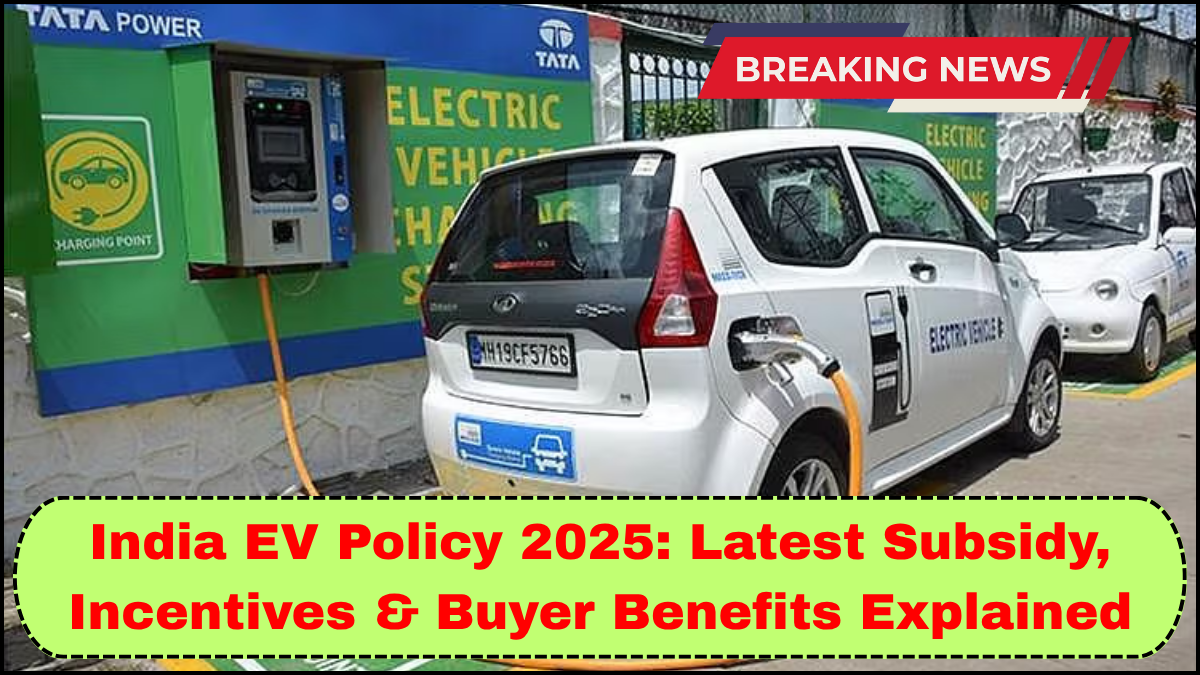India is gearing up for a major transformation in its mobility landscape. The Electric Vehicles India 2025 roadmap is central to the country’s strategy to reduce carbon emissions, cut oil imports, and modernize its transport system. The new EV policy outlines a clear commitment to making electric mobility more accessible, affordable, and appealing for both consumers and manufacturers.
Let’s break down the most important updates in the India EV Policy 2025, from government subsidies and tax benefits to buyer perks and state-level support.

Shift in Policy Focus: From Demand Creation to Ecosystem Building
The 2025 policy marks a strategic pivot. Earlier EV initiatives, such as FAME (Faster Adoption and Manufacturing of Hybrid and Electric Vehicles), mainly focused on subsidies to push EV sales. The 2025 version adds new layers: domestic manufacturing, battery recycling, charging infrastructure, and R&D incentives.
The government aims to make India not just a buyer’s market, but a global EV manufacturing hub. With incentives for both demand and supply sides, the policy sets the stage for long-term sustainability.
Central Subsidy Updates Under FAME III
FAME III, the expected continuation of the flagship subsidy scheme, will expand support in these key areas:
-
Electric two-wheelers and three-wheelers: These categories remain a priority. Direct subsidies continue for eligible models, capped by battery size (₹10,000-15,000 per kWh).
-
Electric buses: Intercity and intra-city electric buses will receive performance-based subsidies to boost public transport electrification.
-
Private four-wheelers: Direct subsidies are limited, but additional tax rebates and state-level benefits improve affordability.
-
Battery-swapping models: Recognizing the need for faster adoption in commercial logistics, battery-as-a-service platforms will enjoy fiscal support.
State-Level Incentives Add More Value
Nearly all major states now have their own EV policies, complementing central support. For example:
-
Delhi offers ₹10,000 per kWh for e-scooters and tax exemptions.
-
Maharashtra provides a maximum subsidy of ₹1.5 lakh on electric cars, plus early bird incentives.
-
Tamil Nadu focuses on EV manufacturing zones, with stamp duty waivers and power subsidies for setting up factories.
-
Karnataka offers capital subsidies to battery manufacturers and EV component suppliers.
These localized benefits stack up with national policies, making EVs more attractive across buyer categories.
GST and Income Tax Benefits
Electric vehicle buyers benefit from a lower GST rate—5% compared to 28% on petrol and diesel vehicles. This alone reduces upfront costs significantly.
Additionally, Section 80EEB of the Income Tax Act allows individuals to claim a deduction of up to ₹1.5 lakh on interest paid on loans taken to purchase EVs. This is a key financial perk for salaried buyers or small business owners looking to switch to clean mobility.
Charging Infrastructure and Swapping Networks
The 2025 EV policy outlines aggressive expansion of public charging stations and swapping hubs. The target is to install at least one charging station every 3 km in cities and every 25 km on highways.
Public-private partnerships are being encouraged. DISCOMs are incentivized to support EV loads, and open access rules have been simplified to ease energy sourcing for charging operators.
Swapping infrastructure, crucial for two- and three-wheelers, will be standardized under new guidelines. This could lower vehicle costs by separating battery ownership from vehicle pricing.
Special Focus on Commercial EV Adoption
Delivery fleets, ride-hailing operators, and public transportation systems are being nudged toward full electrification. Bulk purchase incentives, green registration plates, and reduced permit fees are driving this segment.
Notably, central agencies are collaborating with e-commerce firms and food delivery companies to ensure their fleets go 100% electric by 2030.
Future-Proofing with Innovation and Make in India Push
The EV policy 2025 isn’t just about immediate adoption—it’s designed for longevity. R&D grants, startup incubation, and localization of advanced EV components (like motors, controllers, and BMS) are being prioritized.
To reduce dependency on imports, the Production Linked Incentive (PLI) scheme now includes components critical to the Electric Vehicles India 2025 vision—especially solid-state batteries and advanced chemistry cells.
FAQs on India EV Policy 2025
Q1. What is the main goal of the India EV Policy 2025?
The policy aims to boost the adoption of electric vehicles across all segments while building a domestic ecosystem for EV manufacturing, battery production, and charging infrastructure.
Q2. Are electric cars still eligible for subsidies in 2025?
Direct subsidies for private electric cars are limited, but buyers can benefit from income tax deductions, lower GST, and state-level incentives.
Q3. Which vehicles are eligible under FAME III?
Two-wheelers, three-wheelers, electric buses, and fleet vehicles are prioritized under the upcoming FAME III scheme.
Q4. Can I get tax benefits if I take a loan for an EV?
Yes, under Section 80EEB, individuals can claim up to ₹1.5 lakh in interest deductions on EV loans.
Q5. Are there any benefits for setting up EV charging stations?
Yes, operators receive capital subsidies, easier regulatory clearances, and support from DISCOMs for grid integration.
click here to learn more